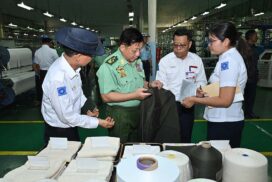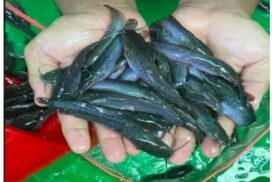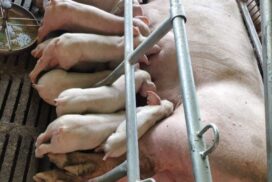By TWA
Historically, Myanmar’s economy is based on agriculture, and so, the major products of the national economy are agricultural products. As stated by the agricultural census conducted in 2003, there are 3.46 million households engaged in agricultural activities with 8.7 million acres of land put under cultivation, it is learnt.
As agriculture is the main sector of Myanmar’s economy, 60 per cent of GDP comes from this sector with 65 per cent of the labour force being engaged in agricultural activities.
Back in 1901, there were only eight and a half million acres of land put under cultivation of paddy. Nevertheless, the paddy-cultivation acres increased to 12.5 million after four decades in 1941. And when World War II broke out in 1945, Myanmar was also stricken by armed conflicts with the result that the draft cattle — the buffaloes and the oxen — were killed in the war by the thousands. The Japanese fascist troops slaughtered the cattle for their curry. With great losses of the farming animals, agricultural activities declined, and the acres of land put under cultivation also decreased. As a consequence, there were only 11.5 million acres of land even in 1961.
Out of the total acres of land under cultivation — i.e. over 17 million acres, about 12 million acres of land were put under cultivation of paddy between 1938 and 1940. Obviously, paddy has always been the major crop. This is the reason why paddy is called metaphorically the lifeblood, the precious gem of Myanmar. And the Delta Area — i.e. the Ayeyawady Region is called the rice barn metaphorically.
Cultivation of paddy plays a significant part in the agricultural sector of Myanmar with paddy cultivation accounting for 34 per cent of cultivation of all crops. In 2013, a total of 27 million tons of rice were produced. For all small and big farms within the country of Myanmar, the major paddy is monsoon paddy. The acres of land under cultivation of monsoon paddy were 15 million while the acres of land under cultivation of summer paddy were two million. In Ayeyawady Region, the acres of land put under cultivation of monsoon paddy were five million or so whereas the acres of land put under cultivation of monsoon paddy were three million or so in Bago Region, two million in Sagaing and one million in Yangon Region respectively. The acres of land put under cultivation of monsoon paddy in the said four regions accounted for 70 per cent of the cultivation of monsoon paddy across the country of Myanmar.
In 2020-2021, the acres of land put under cultivation of monsoon paddy were 15.01 million, and the paddy yield accounted for 1,053.73 million baskets. This year saw 1.66 million tonnes of rice and rice products being exported, earning US$578.94 million.
Around the 1930s in the pre-war period, the export of Myanmar rice accounted for 3.5 million tonnes. However, the export of rice has been on the decline since then. Only after 70 years, the export of rice has risen again, and in the 2017-2018 financial year, 3.6 million tonnes of rice could be exported. In the 2022-2023 financial year, the first half of the financial year witnessed 0.5 million tonnes of rice being exported and 0.36 million tonnes of broken rice being exported, bringing the total to 0.86 million tonnes. Rice was exported to more than 30 countries, with an increase of 0.20 million tonnes when compared to the same period of the previous financial year.
With the increase in the export of rice and broken rice, the government is now boosting agricultural production with greater momentum, and in such doing, the government held Myanmar Rice Conference — 2022 on 6 October 2022 at Myanmar International Convention Centre II in Nay Pyi Taw. The motto for the conference is, “To Boost National Economy, Direct Effort towards Growing of More Paddy.” The conference was honoured by the inauguration speech of State Administration Council Chairman Prime Minister Senior General Min Aung Hlaing.
Delivering the opening speech, the Senior General said, inter alia, that the rice conference was welcomed, that the rice and the rice products were on the priority list which was made in the formulation of the National Export Promotion Strategy and that under the rice export promotion strategy, production and export of quality rice are to be implemented in such a way that the natural environment will not be adversely affected and with the objective of rural area development and generation of greater income.
The population of Myanmar is 55 million now, and those working abroad are about 4.5 million. The rice consumption is 155 kilogrammes (97 pyis) per capita per annum. The rice and paddy production exceeds the domestic consumption dramatically, it is said.
The per acre yield of Monsoon paddy is about 75 baskets whereas that of summer paddy is about 90 baskets, it is estimated by the authorities concerned. If effort can be exerted to increase five baskets each for per acre yield of monsoon and summer paddy, the surplus can ensure higher self-sufficiency and greater export. On the part of the state authorities, they will arrange for providing more inputs like fertilizers and pesticides in addition to ensuring higher availability of irrigation water.
To solve the problem of scarcity of workers, human labour will be replaced with machinery. When human workers are used in harvesting the monsoon paddy, they will naturally be faced with difficulty when there are big rainfalls. But when the machines are used, there will not arise such a problem. Farmers need not be worried about the harvested paddy getting wet in the rain.
The harvesting and winnowing machines can be used when the sun shines. The use of these machines will cost a farmer K90,000 or so per acre. The use of machines costs less when compared to the use of human harvesters. But the costs may vary from region to region.
The drier paddy fetches a higher price. To dry the wet paddy, the bricks that have been baked in the fire are put into the wet paddy. And when the wet paddy is milled, they are to be rid of the pathway with the use of human labour. Now, we can use the drier machines to dry the wet paddy.
The monsoon paddy is sold for K1 million or so per 100 baskets in October. Despite the prices of inputs being high, the farmers are enjoying greater benefits this year.
The export of broken rice accounts for 42 per cent in the first half of this financial year, and the price gap between the price of the new rough rice and that of the broken rice is quite narrow in October.
After the harvest of monsoon paddy, 0.85 million acres of land will be put under cultivation of summer paddy under the Contract Farming system, it is learnt. Contract Farming System is a new dimension in the cultivation of paddy.
Translated.
















